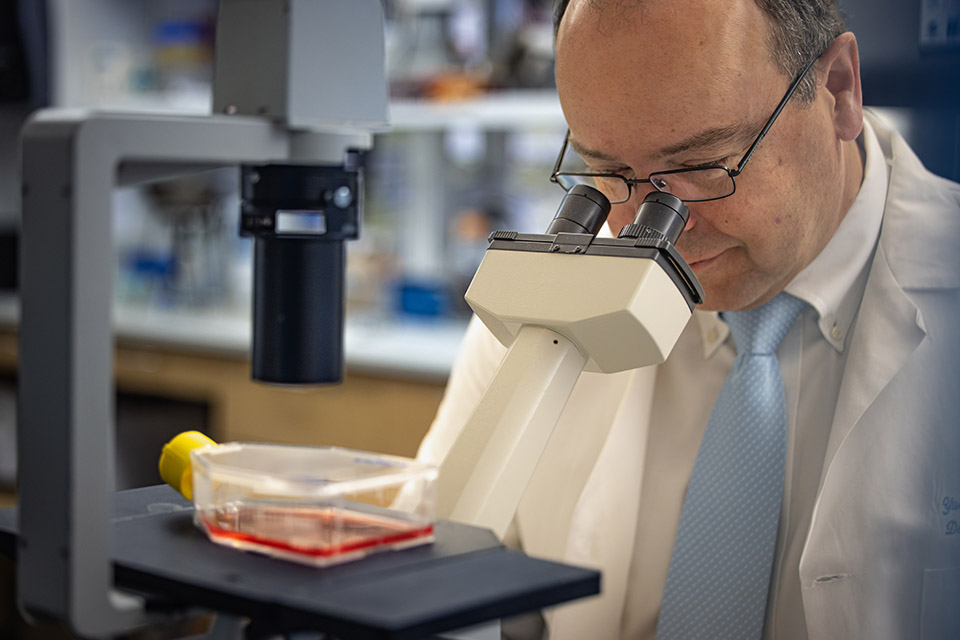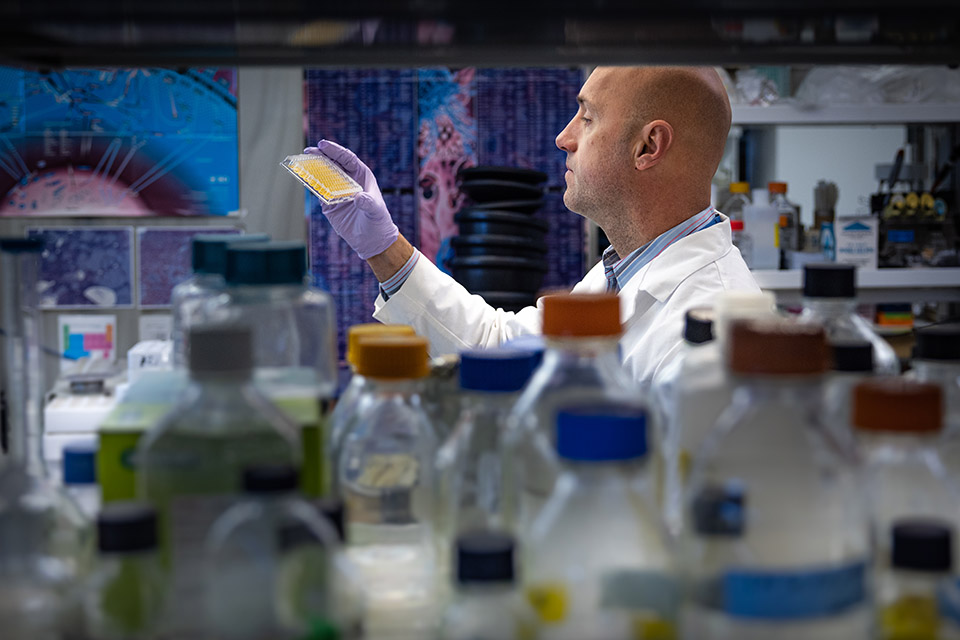Saint Louis University Researchers Identify a Biomarker for Severe Liver Disease in Infants
ST. LOUIS — In a new study, Saint Louis University School of Medicine researchers and colleagues have identified biomarkers in high-risk infants with alpha-1 antitrypsin deficiency (AATD). This is a condition that is life-threatening in some infants but very mild in others. For the first time, predicting which children need lifesaving intervention is possible.
This latest advance follows the discovery of the first possible treatment for adults with AATD by SLU scientists and a Takeda Inc. team in 2022, bringing us nearer to the day when liver transplants are no longer required to treat rare liver disease.

Jeffrey Teckman, M.D., professor of pediatrics and biochemistry and molecular biology, in his lab at the Doisy Research Center on April 11, 2023. Photo by Sarah Conroy.
The findings, which recently appeared in Gastro Hep Advances, suggest that circulating Z polymer levels serve as a biomarker for those with AATD who are likely to develop severe liver disease.
“These data will allow identification of a group of infants at high risk of severe disease soon after diagnosis,” said Jeffrey Teckman, M.D., professor of pediatrics and biochemistry and molecular biology at Saint Louis University.
Teckman is the paper's senior author. He is a leading authority on AATD, a genetic disease that affects one in 3,500 people and has over 100 variants, including ZZ genotypes that increase the risk for lung and liver disease in adults and children.
Symptoms may include shortness of breath and wheezing, repeated infections of the lungs, yellow skin, fatigue, cirrhosis, clinically evident portal hypertension (CEPH), liver failure and even death. Other than a liver transplant, Teckman says there is currently no treatment for AATD.
Scientists have made significant progress in developing new therapies for AATD in recent years, though none are yet approved. While many adult clinical trials enroll participants, none study infants or children. The newly identified biomarkers in infants will stimulate and accelerate future pediatric clinical trials associated with high-risk infants.
“Enrollment of children into trials can then be focused on this high-risk group, sparing many participants from needless trials and speeding the effective treatments to proof of efficacy and approval,” said Teckman, who is also director of pediatric gastroenterology and hepatology at SLU.
The data was collected by the Childhood Liver Disease Research Network (ChiLDReN), a National Institutes of Health (NIH)-supported consortium of pediatric tertiary care centers in North America.
Seventeen consortium centers collected data during the study period, focusing on pediatric liver diseases and aiming to describe the natural history and genetic and environmental modifiers of a group of metabolic-cholestatic liver diseases, including AATD. Researchers measured ZZ AAT serum polymer levels from prospectively collected samples from participants in the Longitudinal Observational Study of Genetic Causes of Intrahepatic Cholestasis (LOGIC) and compared their outcomes in the longitudinal database.

Keith Blomenkamp, senior research assistant in Jeffrey Teckman’s lab, co-authored the paper and is shown here at the Doisy Research Center on April 11, 2023. Photo by Sarah Conroy.
Teckman and his colleagues obtained data and samples to identify biomarkers predictive of severe AATD liver disease. They analyzed prospective AATD ChiLDReN data and serum samples from 251 individuals from 2007-2015 for outcomes and Z polymer levels. Researchers found that 58 of 251 had CEPH at enrollment, and 10 developed CEPH during follow-up. Higher Z AAT polymer levels were associated with existing CEPH. In infants without CEPH, higher polymer levels were related to future CEPH later in childhood, but total AAT was not predictive. In the first few months of life, gamma-glutamyl transpeptidase (GGT), an enzyme found throughout the body, particularly in the liver, was also significantly associated with future CEPH.
Teckman and his colleagues constructed a model identifying subjects at high risk of future CEPH by combining clinical GGT and polymer levels. High circulating Z polymer levels and high GGT early in life are associated with future CEPH in AATD.
Additional authors of the paper include Paula Buchanan, Ph.D., Department of Health and Clinical Outcomes Research, Saint Louis University School of Medicine; Keith Steven Blomenkamp, Departments of Pediatrics and Biochemistry and Molecular Biology, Saint Louis University School of Medicine, SSM Health Cardinal Glennon Children's Hospital; Keith Burling, Core Biochemical Assay Laboratory, Cambridge University Hospitals NHS Foundation Trust, Cambridge, UK; Nina Heyer-Chauhan, Ph.D., UCL Respiratory, Division of Medicine, University College London; and David A Lomas, Ph.D., UCL Respiratory, Division of Medicine, University College London.
Teckman is supported by the ChiLDReN: NIH: DK 62453 and UL1 TR002535 (University of Colorado Denver, Children’s Hospital Colorado, subcontracts), Alpha-1 Foundation, Saint Louis University Liver Center, Cardinal Glennon Children’s Hospital Foundation.
Lomas is supported by the Medical Research Council (UK) (MR/NO24842/1 and MR/V034243/1), the Alpha-1 Foundation (USA), Alpha-1 Awareness and the NIHR UCLH Biomedical Research Centre. He is an NIHR Senior Investigator. University of Michigan, Sample and Data Coordinating Center; NIH-DK062456 (collection and distribution of biosamples and data).
Latest Newslink
- SLU AirCRAFT Lab's Unmanned Aerial System Named Most Innovative at Recent CompetitionAn unmanned aerial system (UAS) built by Saint Louis University's Aircraft Computational and Resource Aware Fault Tolerance (AirCRAFT) Lab was named the most innovative at the 2025 Student Unmanned Aerial Systems (SUAS) Competition. The event is sponsored by RoboNation, a nonprofit organization dedicated to advancing robotics education and workforce development.
- Museum of Contemporary Religious Art Opens Two New ExhibitionsSaint Louis University’s Museum of Contemporary Religious Art (MOCRA) presents two exhibitions that explore the ways in which the places we inhabit shape us and are shaped by us. “To See This Place: Awakening to Our Common Home” and “Legacy: Selections from the Gerald R. and Mary Reid Brunstrom Gift of Art from Australia” open on Friday, Sept. 5.









